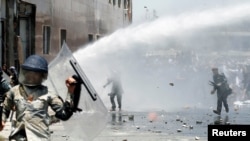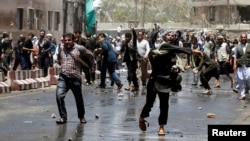Afghan protesters demanded the resignation of President Ashraf Ghani’s government Friday following this week’s devastating truck bomb attack in Kabul, squaring off against police who fired into the air to keep them back.
More than 1,000 demonstrators, many carrying pictures of victims, rallied near the site of Wednesday’s blast, which killed more than 80 people and wounded 460, holding Ghani and Chief Executive Abdullah Abdullah responsible.
Police in riot gear used water cannon and tear gas to block the protesters, many throwing stones, from gaining access to the road leading to the presidential palace, occasionally firing automatic weapons into the air.
Attack one of the worst
Wednesday’s attack, at the start of the Muslim holy month of Ramadan, was one of the worst in Kabul since the U.S.-led campaign to topple the Taliban in 2001 and underlined the growing violence across much of the country.
“The international community has to put pressure on them and force them to resign,” said Niloofar Nilgoon, one of a relatively large number of women taking part in the protest. “They’re not capable of leading the country.”
Others demanded that the government execute prisoners from the Haqqani network, the Taliban-affiliated militant group that intelligence officials blame for the attack.
“Until we do that, we won’t have peace. The only way to get security is to punish criminals,” said another protester, Asadullah, who like many Afghans goes by one name.
Anger complicates US plans
However most of the anger appeared directed against the Western-backed government, underlining growing impatience with its failure to ensure public security, almost three years after most foreign troops left Afghanistan.
“Ghani! Abdullah! Resign! Resign!” read one banner with the pictures of bloodstained children and held out of a car window.
The pressure on the government complicates the choice facing U.S. President Donald Trump’s administration, which is considering plans to increase the number of American troops in the country by between 3,000 and 5,000 to help break what U.S. commanders say is a stalemate in the war.
Taliban insurgents now control or contest around 40 percent of the country. Even before the attack, 715 civilians had been killed in the first three months of the year after nearly 3,500 in 2016, the deadliest year on record for Afghan civilians.











